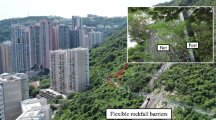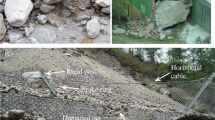Abstract
A case study on an open hillside landslide impacting on a flexible rockfall barrier at Jordan Valley, Hong Kong is presented in this paper. The landslide occurred sometime in June 2008. This is so far the only case history of landslide debris having been intercepted by a flexible rockfall barrier in Hong Kong. The landslide scar is 10 m wide and 7 m long, and the landslide volume is about 110 m3. The landslide debris was largely retained by the barrier but two of the barrier posts were severely damaged and failed. Debris mobility analysis and structural analysis of this case history have been undertaken with a view to obtaining a better understanding of the possible landslide dynamics and behaviour of flexible barrier upon debris impact. The analyses appear to have reproduced some of the salient field observations. The probable key contributory factors to the failure are highlighted and discussed. Through the study, the possible range of equivalent pseudo-static impact pressure exerted on the flexible barrier by the landslide debris is assessed. The site observations and results of the analyses provide insights pertaining to the importance of robustness in the design and detailing of flexible debris-resisting barriers.

















Similar content being viewed by others
References
Bartelt P, Volkwein A, Wendeler C (2009) Full scale testing and dimensioning of flexible debris flow barriers. Summary report of the 2005–2008 CTI-Project “Numerical modeling and design of flexible debris flow barriers”. Swiss Federal Institute for Forest, Snow, and Landscape Research (WSL), Switzerland
BD (2011) Code of practice for the structural use of steel 2011. Buildings Department, HKSAR Government, Hong Kong
Bichler A, Yonin D, Stelzer G (2012) Flexible debris flow mitigation: introducing the 5.5 mile debris fence. In: Eberhardt E, Froese C, Turner AK, Leroueil S (eds) Landslides and engineered slopes: protecting society through improved understanding. CRC Press, New York, pp 1955–1960
Bugnion L, Wendeler C (2010) Shallow landslide full-scale experiments in combination with testing of a flexible barrier. In: De Wrachien D, Brebbia CA (eds) Monitoring, simulation, prevention and remediation of dense and debris flows III. WIT Press, Southampton, pp 161–173
Chan SL (1988) Geometric and material nonlinear analysis of beam-columns and frames using the minimum residual displacement method. Int J Numer Methods Eng 26:2657–2669
Chan SL, Zhou ZH, Liu YP (2012) Numerical analysis and design of flexible barriers allowing for sliding nodes and large deflection effects. In: C.K. Lau, E. Chan and J. Kwan (Eds). Proceedings of the One Day Seminar on Natural Terrain Hazards Mitigation Measures, 16 October 2012, Hong Kong. The Association of Geotechnical and Geoenvironmental Specialists (Hong Kong) Limited, pp. 29–43
DeNatale JS, Iverson RM, Major JJ, LaHusen RG, Fiegel GL, Duffy JD (1999) Experimental testing of flexible barriers for containment of debris flows. USGS Open-File Report 99-205, US Geological Survey
Duffy JD (1998) Case studies on debris and mudslide barriers systems in California. In: C.K. Lau, R.P. Martin and K.T. Chau (eds). Proceedings of the One Day Seminar on Planning, Design and Implementation of Debris Flow and Rockfall Hazards Mitigation Measures, Hong Kong, 27 October 1998. The Association of Geotechnical Specialists (Hong Kong) Ltd. and The Hong Kong Institute of Engineers (Geotechnical Division), pp. 77-90
GEO (2012) Guidelines on assessment of debris mobility for open hillslope failures, (technical guidance note no. 34). Geotechnical Engineering Office, HKSAR Government
Hind KJ, McArdell BW (2010) Numerical modelling of debris-flows and mitigation structures at Matata, New Zealand. In: A.L. Williams, G.M. Pinches, C.Y. Chin, T.J. McMorran and C.I. Massey (eds). Geologically active: Proceedings of the 11th IAEG Congress. Auckland, New Zealand, 5–10 September 2010. New York: CRC Press, pp. 3003–3010
Hungr O (1995) A model for the runout analysis of rapid flow slides, debris flows and avalanches. Can Geotech J 32:610–623
Isofer (2012) TranServ—Trunk Road Network North West Scotland A83 Rest and be Thankful—phases 3 and 4 debris flow and shallow landslide protection. Isofer AG, Switzerland
Kwan JSH, Sun HW (2006) An improved landslide mobility model. Can Geotech J 43:531–539
Margreth S, Roth A (2008) Interaction of flexible rockfall barriers with avalanches and snow pressure. Cold Reg Sci Technol 51:168–177
Nicot F, Cambou B, Mazzoleni G (2001) From a constitutive modeling of metallic rings to the design of rockfall resisting nets. Int J Numer Anal Methods Geomech 25:49–70
Pederzani A, Calegari L, Guasti G, Balatti F, Fasola R (2009) Flexible ring net barriers preferred to concrete works: the Riale Buffaga experience (Ronco s./Ascona, Switzerland), Technical Documentation, February 2009. Geobrugg AG, Switzerland
Roth A, Kästli A, Frenez Th (2004) Debris flow mitigation by means of flexible barriers. Proceedings of the International Symposium Interpraevent 2004, Trento, Italy
Volkwein A (2004) Numerical simulation of flexible rockfall protection systems. PhD Thesis, Swiss Federal Institute of Technology Zürich, Switzerland (in German)
Wartmann S, Salzmann H (2002) Debris flow and floating tree impacts on flexible barriers. In: Proceedings of the Conference on Natural Terrain—a constraint to development, Hong Kong, 14 November 2002. Institution of Mining and Metallurgy, Hong Kong Branch, pp 125–131
Wendeler C, McArdell BW, Rickenmann D, Volkwein A, Roth A, Denk M (2006) Field testing and numerical modelling of flexible debris flow barriers. In: CWW Ng, LM Zhang, YH Wang (eds). Proceedings of the Sixth International Conference of Physical Modelling in Geotechnics, Hong Kong, 4–6 August 2006. pp 1573–1604
Wendeler C, Volkwein A, Denk M, Roth A, Wartmann S (2007) Field measurements used for numerical modelling of flexible debris flow barriers. In: CL Chen, JJ Major (eds). Proceedings of Fourth International Conference on Debris Flow Hazards Mitigation: Mechanics, Prediction, and Assessment, Chengdu, China, 10–13 September 2007. pp. 681–687
Wendeler C, Haller B, Salzmann H (2012) Protection against debris flows with 13 flexible barriers in the Milibach River (Canton Berne, Switzerland) and first event Analysis. In: C.K. Lau, E. Chan, J. Kwan (eds). Proceedings of the One Day Seminar on Natural Terrain Hazards Mitigation Measures, 16 October 2012, Hong Kong. The Association of Geotechnical and Geoenvironmental Specialists (Hong Kong) Limited. pp 22–28
Zhou ZH, Liu YP, Chan SL (2011) Nonlinear finite element analysis and design of flexible barrier (Project Report). The Hong Kong Polytechnic University
Acknowledgments
This paper is published with the permission of the Head of Geotechnical Engineering Office and the Director of Civil Engineering and Development of the Government of the Hong Kong Special Administrative Region.
Author information
Authors and Affiliations
Corresponding author
Appendixes
Appendixes
Annex A—Properties and dimensions of the structural components of the barrier adopted in setting up the structural model
Ring net
-
1.
Diameter of ring: 350 mm
-
2.
Diameter of ring wire: 3 mm (7 spirals)
-
3.
Six rings connection
Hollow steel post
-
1.
Height: 5 m
-
2.
Size: 140 mm × 140 mm
-
3.
Thickness: 4 mm
-
4.
Radius of gyration: 55.2 mm
-
5.
Cross section area = 2.14 × 103 mm2
-
6.
Moment of inertia = 6.52 × 106 mm4
-
7.
Section modulus = 93.1 × 103 mm3
-
8.
Yield stress = 235 MPa
-
9.
Elastic modulus = 200 GPa
-
10.
Founded on shallow concrete footing of dimensions 400 mm × 400 mm × 500 mm depth
Energy dissipating device
The energy dissipating devices attached to the uphill cables were not activated as observed during the site inspections. Energy dissipating device is therefore not included in the structural model.
Extension rope cables
-
1.
Diameter of top rope cable is 20 mm (6 threads of 19 wires)
-
2.
Diameter of bottom rope cable is 20 mm (6 threads of 19 wires)
-
3.
Tensile failure load is 270 kN
Annex B—Estimation of energy dissipation by plastic deformations of barrier posts and failure of post foundations
B.1 Energy dissipation by plastic deformations of barrier posts
Energy dissipation by plastic deformations of barrier posts could be estimated based on plastic moment of the posts and the angle of rotation:
where
- M p :
-
plastic moment of the structural member
- θ :
-
angle of rotation
M p is the multiple of the sectional modulus (Z) and yield stress (σ p ) which equal to 22 kNm. Z and σ p of the steel posts are 93.1 × 103 mm3 and 235 MPa respectively. However, M p is reduced to 14 kNm due to buckling failure (see M x for post P1 shown in Table 1). Site inspections indicated that the angle of rotation of posts P1 and P15 was about 90°, i.e. θ is taken as π/2. It follows that energy dissipation due to bucking of the two posts is 44 kJ for two failed posts (i.e. P1 and P15).
B.2 Energy dissipation by failure of post foundations
The energy dissipation due to foundation failure of posts relates to the sliding resistance (R T ) acting on the post foundation and the displacement of the foundation. A simplified approached is adopted in this calculation. It is assumed that R T , which comprises the resistance acting on the base of the foundation (R S ) and the passive resistance (R P ), is constant throughout displacement process (see Fig. 18).
Calculation of R P :
where
- k p :
-
is passive pressure coefficient = 3.7 (using Rankin theory with friction angle at the interface of the foundation and ground = 35° assumed)
- γ :
-
is unit weight of soil, assumed to be 18 kN/m2
- H :
-
is depth of foundation = 0.5 m
- w :
-
is width of foundation = 0.4 m
Hence, R p = 6.7 kN (say 7 kN)
Calculation of R S :
where
- N :
-
is normal force acting on the base of foundation (=68 kN), which is the calculated axial compression force when UDP = 50 kPa (see Table 1), with self-weight and side friction neglected
- ϕ :
-
is friction angle at the interface of the foundation and ground = 35° assumed
Hence, R S = 48 kN
Total sliding resistance, R T = R S + R P = 55 kN
Energy dissipation is approximated by the multiple of R T and displacement of foundations. The displacements of posts P1 and P15 are 2.2 and 1 m, respectively, as observed on site. It follows that the energy dissipation due to failure of post foundation is 176 kJ.
Rights and permissions
About this article
Cite this article
Kwan, J.S.H., Chan, S.L., Cheuk, J.C.Y. et al. A case study on an open hillside landslide impacting on a flexible rockfall barrier at Jordan Valley, Hong Kong. Landslides 11, 1037–1050 (2014). https://doi.org/10.1007/s10346-013-0461-x
Received:
Accepted:
Published:
Issue Date:
DOI: https://doi.org/10.1007/s10346-013-0461-x





